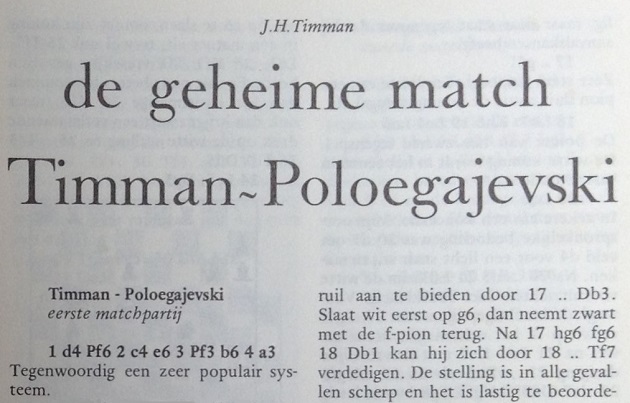Chess Notes
Edward Winter
When contacting us by e-mail, correspondents are asked to include their name and full postal address and, when providing information, to quote exact book and magazine sources. The word ‘chess’ needs to appear in the subject-line or in the message itself.
| First column | << previous | Archives [132] | next >> | Current column |
9361. Spassky v Karpov, 1972
The Factfinder has a number of references to ‘secret’ chess encounters, e.g. matches whose outcome (or even existence) was not disclosed at the time. Another case, involving Spassky and Karpov, was mentioned by the latter in an interview with Irwin Fisk posted by ChessBase on 2 March 2015:
‘I.F.: Spassky was in preparation to play Fischer for the world championship. Had you played Spassky?
A.K.: Yes, I played a training match with Spassky. He asked me to play training games, but we played only one game. Spassky won this game even though he had a lost position, but I made a stupid mistake, and after this suddenly Spassky said he didn’t want to continue this training match, so maybe he was happy he beat me in that game.
I.F.: Where was this game played?
A.K.: We were near Moscow.’
A similar, though more detailed, account is on pages 98-99 of Karpov on Karpov (New York, 1990):
‘Toward the end of the camp, Spassky, wishing to check his form, decided to play several games with me. In the first game, he selected the Ruy López. I played White and quickly gained a winning position. All I had to do was hold on to it for a little while longer, but, weary from the previous inactivity and irritated by how I was being treated, I decided to show off and embarked upon unnecessary tactical complexities. This gave Spassky a chance to display his customary resourcefulness. I should have regrouped in time, changed the arrangement, and played to at least hold on to what remained. But I already realized my lead was receding, and I overplayed and lost. Spassky liked this game. He decided that his form was superior and there was no reason to continue checking it. My participation in his final prematch training was virtually limited to this one game.’
On page 8 of the September 1989 Chess Life A. Soltis disseminated a different version:
‘In some instances, no details about a match are ever disclosed. Or a smidgen of information surfaces, such as after the 1972 world championship match, when Anatoly Karpov confirmed the rumors that he had played a match to help prepare Boris Spassky for the challenge of Bobby Fischer. All Karpov would say then about the result was “I did not lose”.’
A similar text appeared on page 148 of Soltis’s book Karl Marx Plays Chess (New York, 1991), but in neither case did he offer the reader any source. It is possible that he was relying on a mere rumour published, as an editorial end-note, on page 70 of the February 1973 Chess Life & Review:
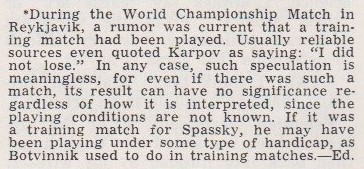
9362. Abelard
From page 67 of Teaching Chess in the 21st Century by Todd Bardwick (Englewood, 2004):

The famous ‘gymnasium of the mind’ quote was discussed in C.N. 3626 (see Chess: the Need for Sources). As regards the attribution to Abelard, how anybody could place terms such as ‘keep your brain fit’, ‘the ego’ and ‘your local gymnasium’ in the Middle Ages is not easily understood.
9363. Photographic archives (2)
Some further photographs from our archive collection which was mentioned in C.N. 9325:
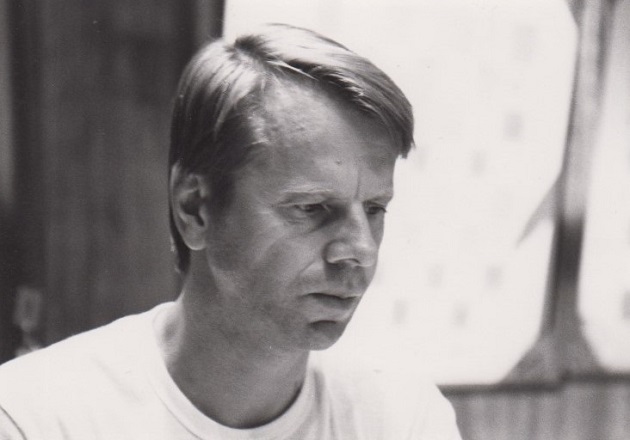
Ulf Andersson
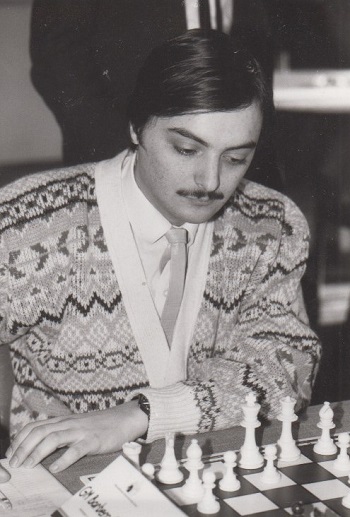
Gerardo Barbero
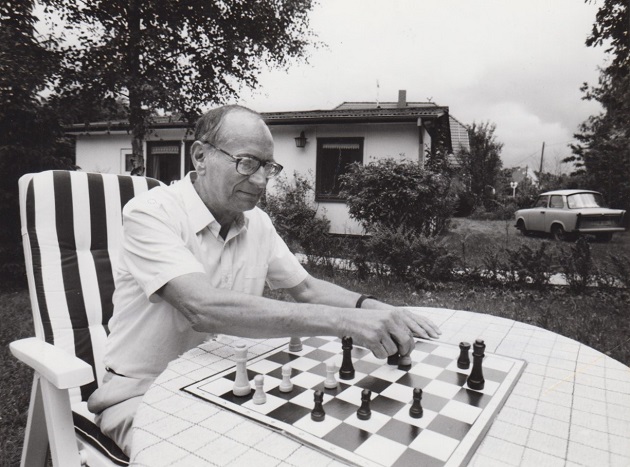
Friedrich (Fritz) Baumbach
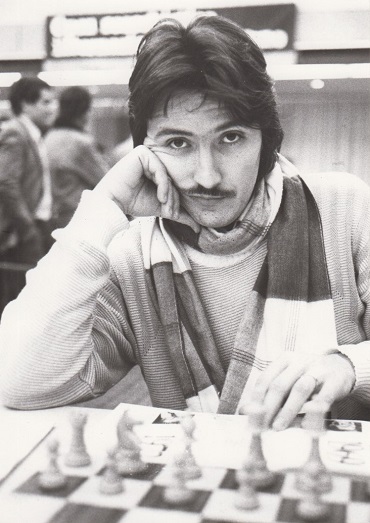
Werner Hug
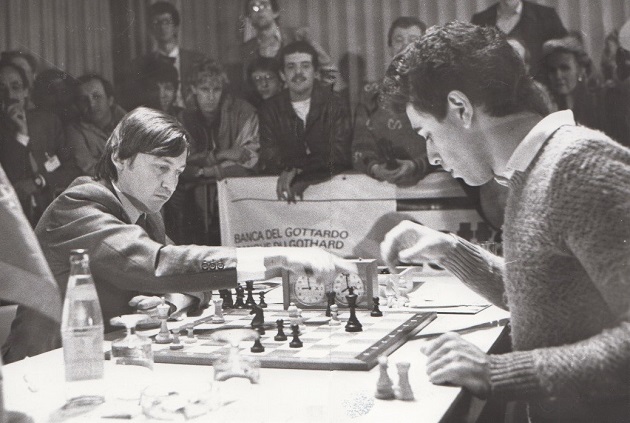
Anatoly Karpov and Yasser Seirawan
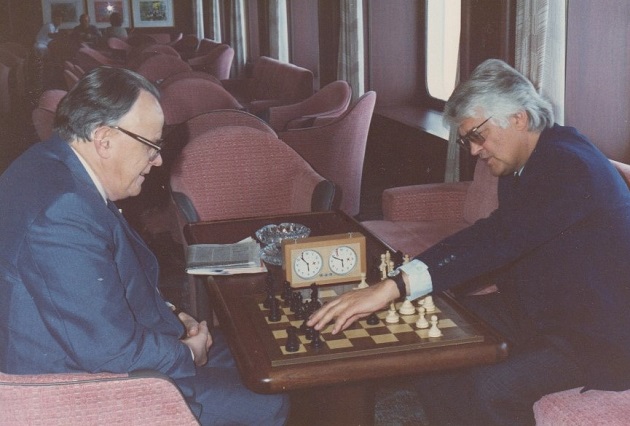
Ludĕk Pachman and Lothar Schmid
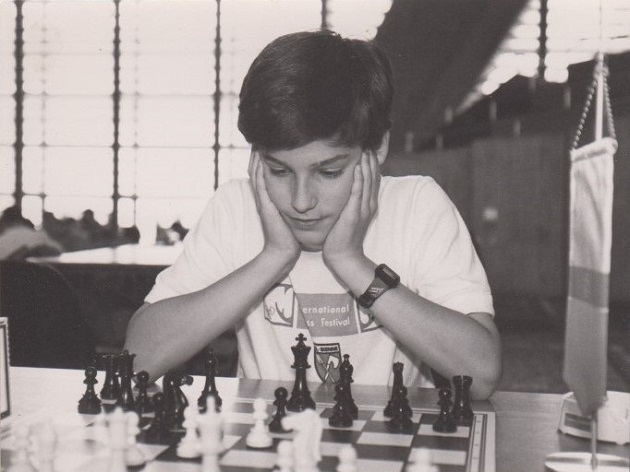
Yannick Pelletier
9364. A Lasker story
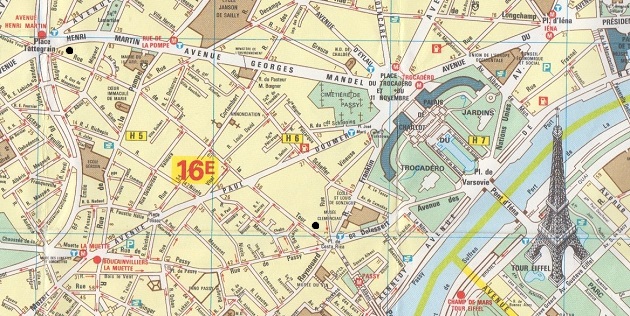
Paris (Michelin). Larger version
The two black dots mark the Rue de la Tour, which was mentioned in one version of an old story concerning Emanuel Lasker’s alleged absent-mindedness and impracticality, as evinced by an inability to find his accommodation. It is a tale related in Proustian detail (beginning airily with ‘einmal’) on page 72 of Emanuel Lasker Biographie eines Schachweltmeisters by J. Hannak (Berlin-Frohnau, 1952), as well as on pages 79-80 of the English-language version (London, 1959). Lamentably, it was even included on page 104 of the ‘New 21st Century Edition!’ of Lasker’s Manual of Chess (Milford, 2008); another example of disrespectful dumbing-down was on page 142, which gave the pigeon-breeding story (see C.N. 3662).
An unsigned item (beginning airily with ‘once’) on page 182 of the 15 April 1957 CHESS concluded with an exact address (12 Rue de la Tour, Paris):
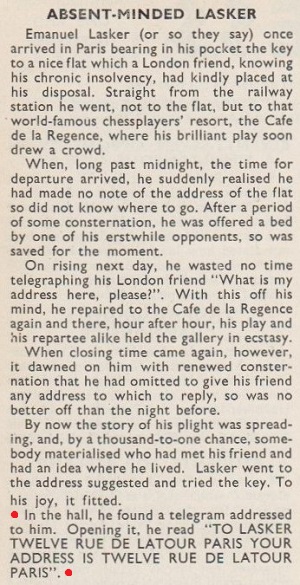
More space was filled on page 230 of CHESS, 20 June 1957 with a letter from Heinrich Fraenkel (the translator of Hannak’s book from German to English):
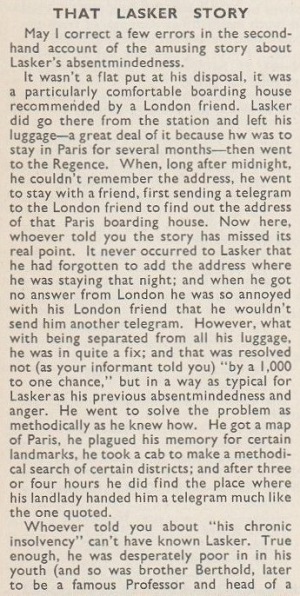
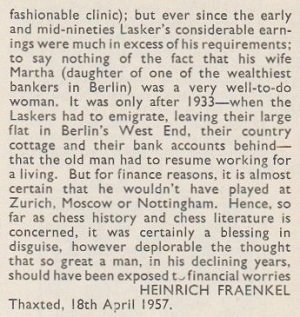
Such anecdotal rambles reveal little about Lasker, though much about the ramblers. Readers should trust nobody who unquestioningly relates ‘fun’ material about old chess masters’ déboires with hotels, restaurants and luggage, but it may sometimes be worth trying to trace who came up with what, and why. In this case, for instance, what is the explanation for ‘12 Rue de la Tour’?
9365. Nimzowitsch game
Per Skjoldager (Fredericia, Denmark) has forwarded pages 132-133 of Der Schachwart, July 1931:
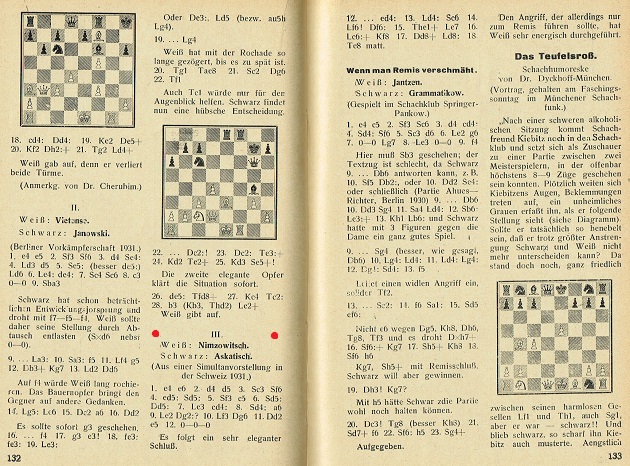
Our correspondent notes that this game, supposedly played by Nimzowitsch in 1931 against Askatisch in a simultaneous exhibition in Switzerland, is identical to his famous offhand win against Alapin. Can further particulars be found?
Below is a table of Nimzowitsch’s results in simultaneous displays during his Swiss tour, as reported on page 36 of the March 1931 issue of the Schweizerische Schachzeitung.
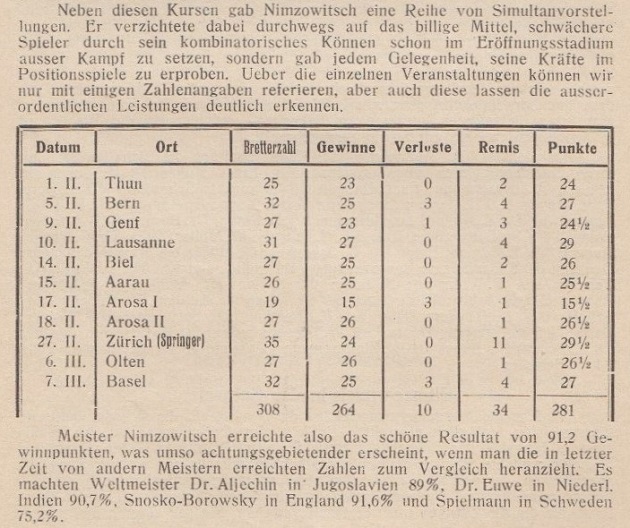
9366. Capablanca in Portland
Russell Miller (Vancouver, WA, USA) sends two games which have been found by Casey Bush on page 4 of the Sunday Oregonian, 23 April 1916. They were the only simultaneous games which Capablanca did not win during his stay in Oregon.
José Raúl Capablanca – R.T. Leonard
Portland, 6 April 1916
Queen’s Gambit Declined
1 d4 d5 2 Nf3 Nf6 3 c4 c6 4 Nc3 e6 5 e3 Bb4 6 Bd3 O-O 7 O-O Nbd7 8 Qc2 h6 9 Ne2 dxc4 10 Bxc4 Re8 11 e4 e5 12 Qb3 Qe7 13 dxe5 Nxe4 14 Ned4 Nb6
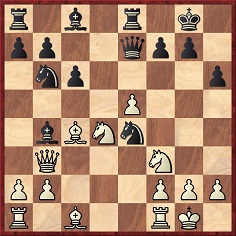
15 Bxf7+ Qxf7 16 Qxb4 c5 17 Qe1 Qd5 18 Nb5 Re7 19 Nc3 Nxc3 20 Qxc3 Bg4 21 Bf4 Bxf3 22 gxf3 Rf8 23 Rfd1 Qf7 24 Qxc5 Rc7 25 Qd6 Rc6 26 e6 Qg6+ 27 Bg3 Rxd6 28 Rxd6 Nc4 29 Rd4 Qxe6 30 Kg2 Qf7 31 Rf4 Qd5 32 Re4
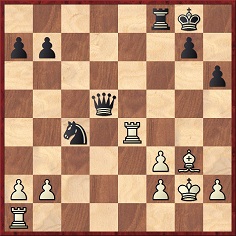
32...Rxf3 33 Kxf3 Nd2+ 34 Ke2 Nxe4 35 Rd1 Nxg3+ 36 hxg3 Qxa2 37 Rd2 b6 38 f4 a5 39 Ke3 b5 40 g4 a4 41 g5 hxg5 42 fxg5 b4 43 Kf4 Qf7+ 44 Kg4 Qf8 45 Rd4 a3 46 bxa3 b3 47 White resigns.
José Raúl Capablanca – H. Kurth
Portland, 6 April 1916
Ruy López
1 e4 e5 2 Nf3 Nc6 3 Bb5 a6 4 Ba4 Nf6 5 O-O Bc5 6 c3 b5 7 Bc2 d6 8 d4 Bb6 9 dxe5 dxe5 10 Qxd8+ Kxd8 11 a4 Bb7 12 axb5 axb5 13 Rxa8+ Bxa8 14 Na3 b4 15 Nc4 Nd7 16 Rd1 f6 17 Ba4 bxc3 18 bxc3 Kc8

19 Rxd7 Kxd7 20 Ncxe5+ fxe5 21 Nxe5+ Ke6 22 Nxc6 Bxc6 23 Bxc6 Rf8 24 Bd5+ Ke5 25 h4 Bxf2+ 26 Kh2 Bxh4 27 g3 Bd8 28 Bf4+
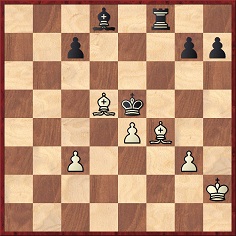
28...Rxf4 29 gxf4+ Kxf4 30 Kh3 g5 31 Kg2 h5 32 e5 h4 33 e6 g4 34 Kh2 Be7 35 Kg2 Bd6 36 Kh1 Kg3 37 Bc6 Kf4 38 Ba4 h3 39 Bd7 g3 40 Bc6 g2+ 41 Bxg2 hxg2+ 42 Kxg2 Ke3 43 White resigns.
9367. Games played in secret
Further to C.N. 9361 (Spassky v Karpov, 1972), Joop Elderhorst (Rotterdam, the Netherlands) writes:
‘In Summer 1979, Timman and Polugayevsky played a secret match in the Netherlands in preparation for their respective Interzonal tournaments (Timman in Rio de Janeiro and Polugayevsky in Riga). Timman won +2 –1 =5 and discussed the match on pages 3-20 of the October 1979 issue of Schaakbulletin.
Donner wrote an article about the event in De Volkskrant, 11 August 1979; see pages 314-317 of his book The King (Alkmaar, 2006).’
Our items on this theme have now been brought together in Secret Chess Contests.
9368. Norway Chess 2015
The latest addition to our collection of memorabilia:
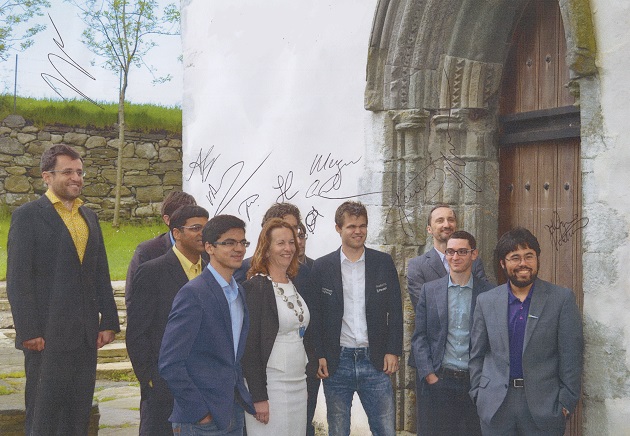
Recent signed items are seldom shown in C.N., but it is always greatly appreciated when readers assist us in acquiring them.
9369. Tarrasch, sea air and other explanations (C.N.s 5517, 5707 & 5724)
From page 79 of How to Play Chess Like a Champion by Fred Reinfeld (New York, 1956):
‘Tarrasch was certainly one of the great masters of all time. His brilliant period extended from 1889 to 1907. Order and method were his gods. When everything went right, he was unbeatable. But he ruled out the personal factors in chess, and that was his undoing. In defeat poor Tarrasch had the longest list of the most curious alibis ever seen in the chess world. In fact, some people rudely suggested that his alibis were more ingenious than his chess.’
Easy to write, harder to substantiate.
9370. ‘Friedman’
Further to the stories related in ‘Fun’, below is how half of page 66 of Objectif mat! by Raoul Bertolo and Louis Risacher (Paris, 1978) was filled:
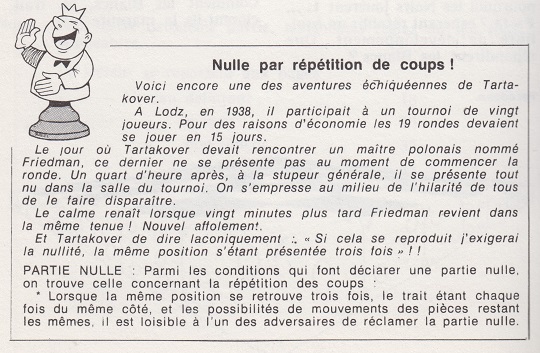
9371. Capablanca in Portland (C.N. 9366)
Another simultaneous game can be added, from page 5 of the Sunday Oregonian, 4 June 1916:
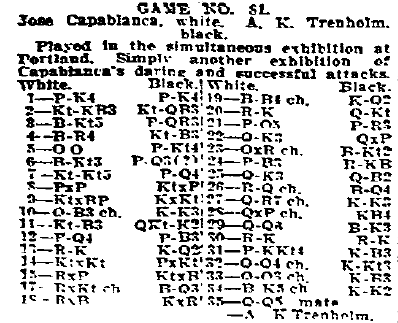
The score goes awry towards the end of the first column, but ...Ra7 was evidently played, and we therefore give the game as follows:
José Raúl Capablanca – A.K. Trenholm
Ruy López
Portland, April 1916
1 e4 e5 2 Nf3 Nc6 3 Bb5 a6 4 Ba4 Nf6 5 O-O b5 6 Bb3 d6 7 Ng5 d5 8 exd5 Nxd5

9 Nxf7 Kxf7 10 Qf3+ Ke6 11 Nc3 Ne7 12 d4 c6 13 Re1 Kd7 14 Nxd5 cxd5 15 Rxe5 Ra7 16 Bxd5 Nxd5 17 Rxd5+ Bd6

18 Rxd6+ Kxd6 19 Bf4+ Kd7 20 Re1 Qg8 21 d5 h6 22 Qe3 Qxd5 23 Qxa7+ Bb7 24 f3 Rf8 25 Qe3 Qf7 26 Rd1+ Bd5 27 Qa7+ Ke6 28 Qxa6+ Kf5 29 Qd6 Be6 30 Re1 Re8 31 g4+ Kf6 32 Qd4+ Kg6 33 Qd3+ Kf6 34 Be5+ Ke7 35 Qd6 mate.
9372. Capablanca v Trenholm (C.N. 9371)
Christian Sánchez (Rosario, Argentina) has found online a clearer version of the chess column on page 5 of the Sunday Oregonian, 4 June 1916 from which we took the Capablanca v Trenholm game:
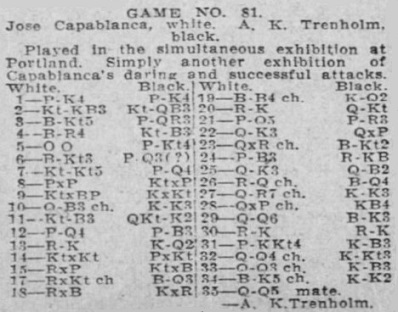
9373. Sämisch blindfold brilliancy
1 e4 c5 2 Nf3 d6 3 Bb5+ Bd7 4 Bxd7+ Qxd7 5 O-O Nc6 6 d4 cxd4 7 Nxd4 e6 8 c4 Nf6 9 Nc3 Be7 10 b3 O-O 11 Bb2 Rfd8 12 Qd2 Ne8 13 Rad1 a6 14 Nc2 Qc7 15 Ne3 Qb8 16 Qe2 b5 17 Rd2 Ne5 18 f4 Ng6 19 Qf2 Qb6 20 f5 Bg5
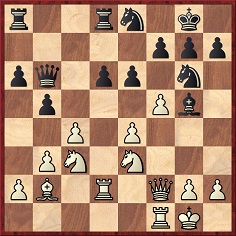
21 Ncd5 exd5 22 Bd4 Qb7 23 fxg6 hxg6 24 Nxd5 Bxd2 25 Qxd2 Rab8 26 Qg5 Rd7 27 Rf3 bxc4 28 Rh3 cxb3

29 Nf6+ Nxf6 30 Qxf6 gxf6 31 Bxf6 Resigns.
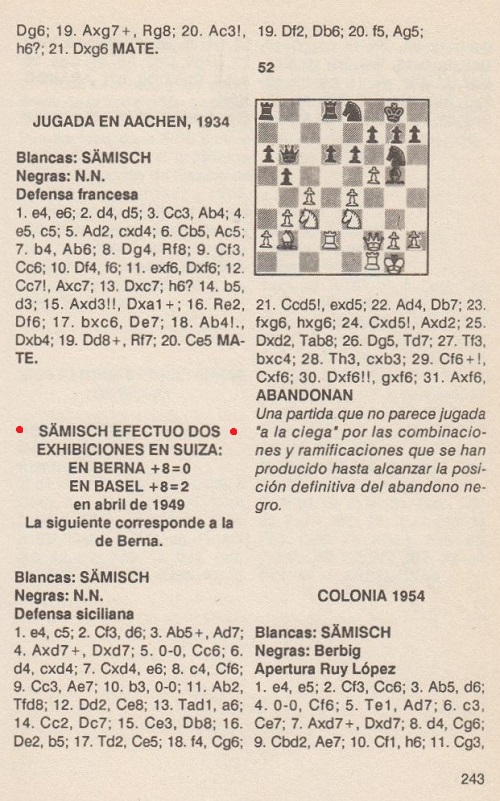
The above is page 243 of Ajedrez a la ciega by Benito López Esnaola (Madrid, 1989); see too page 385 of Blindfold Chess by Eliot Hearst and John Knott (Jefferson, 2009). The reference in the game heading to April 1949 is incorrect, as shown below.
The score was not published in the main Swiss chess periodical of the time, the Schweizerische Schachzeitung, although page 110 of the July 1949 issue had a brief report on Sämisch’s display in Berne:

Richard Forster (Zurich) has forwarded us two chess columns by Erwin Voellmy in the Basler Nachrichten, the first dated 29 January 1949:
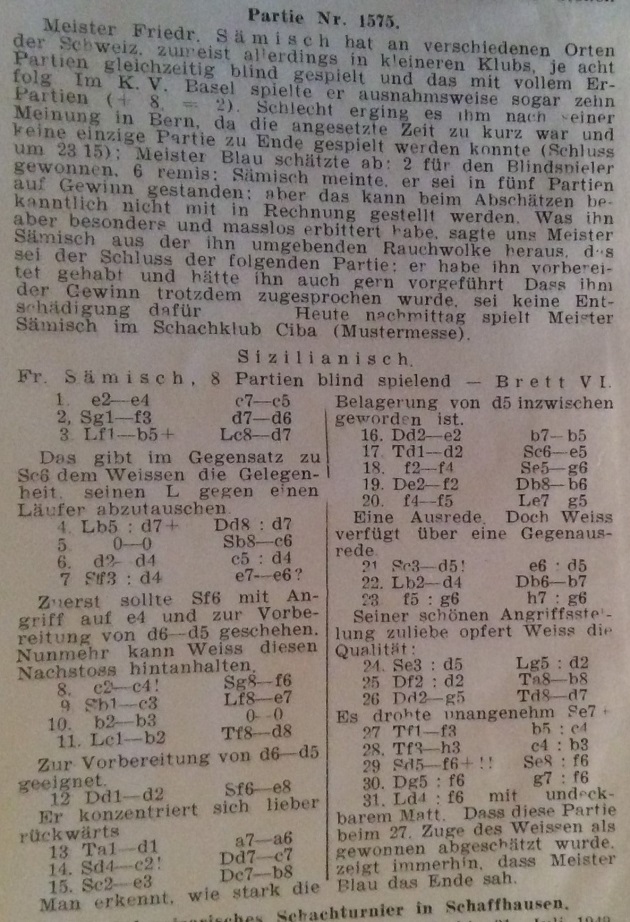
Thus, owing to the late hour Sämisch had no opportunity to play the combinative finish against his unidentified opponent. The game was adjudicated at move 27 (after Rf3).
The second column (Basler Nachrichten, 5 February 1949) had a small correction concerning the number of games broken off:
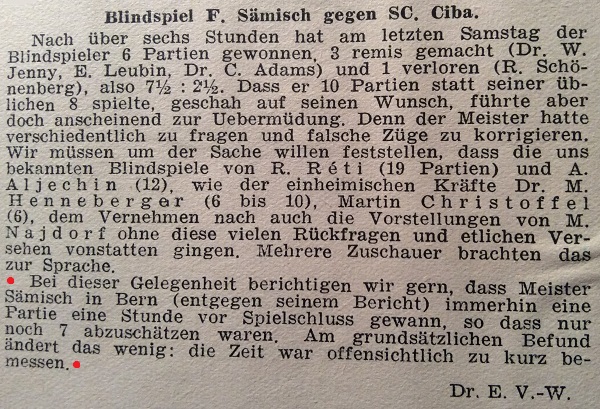
The brilliancy can be found in a number of publications with Black identified as Koller. For instance, it is game 25 in 60 champions ... 60 parties by Alain Benlolo (Nice, 1992), a booklet subtitled ‘les plus belles parties d’échecs de tous les temps’. Certainly there was a player in Berne named Koller – in another context he was mentioned, for example, on page 45 of the March 1949 issue of the Schweizerische Schachzeitung – but when was the name Koller first attached to the Sämisch game?
9374. A thousand years
Page 39 of Famous Chess Players by Peter Morris Lerner (Minneapolis, 1973):
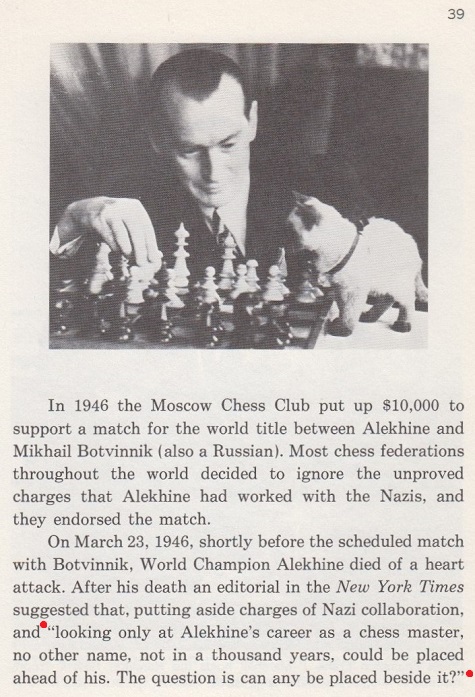
It is easy to imagine writers reproducing the New York Times quote from that book, perhaps to glorify Alekhine or, alternatively, to criticize the newspaper’s suggestion that his claimed supremacy would endure for 1,000 years.
The text provides a curious illustration of how nothing in secondary sources should be accepted at face value. The brief New York Times article was published shortly after Alekhine’s death (in the 26 March 1946 edition), and below are the opening and closing passages:
‘When a game has been played for a thousand years the naming of one man as its greatest exponent requires an act of daring. ...
A pity that it [Alekhine’s life] was clouded at the close by charges of Axis collaboration based on a tangle of incidents yet to be explained. Leaving that aside, however, and looking only at Alekhine’s career as a chess master, no other name, not in the whole 1,000 years, can be placed ahead of his. The question is, Can any be placed beside it?’
9375. A knight on e6
Concerning the quote attributed to Adolf Anderssen which was discussed in C.N. 3514 (see too Chess: the Need for Sources), an additional claim was on page 59 of Modern Master-Play by F.D. Yates and W. Winter (London, 1929):
‘Marshall is very partial to posting a knight on Q4, and certainly the piece is very effective there, as he is within range of a number of vital squares, notably KB5 and K6. Of the latter Anderson [sic] said: “If a player can firmly plant a knight on K6 he can go to sleep for the rest of the game”.’
9376. From a book review by Potter
From W.N. Potter’s review of Chess Chips by J. Paul Taylor (London, 1878), on page 129 of the Huddersfield College Magazine, February 1879:
‘Beginning with the Preface, I think I must congratulate the author upon its brevity. Prose composition is evidently not his strong point, and therefore he is wise not to attempt much in that line.’
9377. ‘Never miss a check’ (C.N.s 6416, 6432 & 9094)
On page 37 of Impact of Genius (Seattle, 1992) R.E. Fauber wrote:
‘Morphy did secure competition from Seymour Boden (“Never miss a check. It might be mate.”) and checked him to death.’
It is unclear why Boden was attributed the remark or, indeed, the forename Seymour.
9378. Women composers
Hassan Roger Sadeghi (Lausanne, Switzerland) points out a webpage on women chess composers.
9379. A Tarrasch principle
A principle put forward by Tarrasch:
‘Better a mobile pawn majority on a flank than a blocked passed pawn in the centre.’
Source: page 336 of The Game of Chess by S. Tarrasch (London, 1935). The original German text on page 424 of Das Schachspiel (Berlin, 1931) was:
‘Besser eine mobile Bauernmajorität auf einem Flügel als ein gestoppter Freibauer im Zentrum.’
The position presented by Tarrasch to illustrate the principle came after 1 d4 d5 2 c4 dxc4 3 Nf3 c5 4 d5 e6 5 e4 exd5 6 exd5 Nf6 7 Bxc4 Bd6:
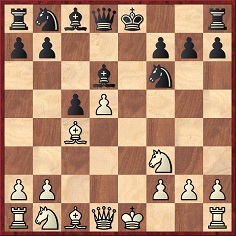
9380. A.G. Laing (C.N.s 8728, 8762, 8877 & 8967)
Another game from the score-books of A.G. Laing:
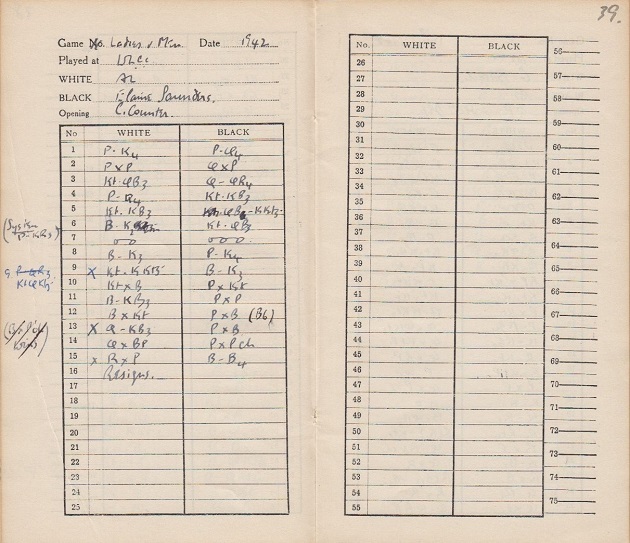
1 e4 d5 2 exd5 Qxd5 3 Nc3 Qa5 4 d4 Nf6 5 Nf3 Bg4 6 Be2 Nc6 7 O-O O-O-O 8 Be3
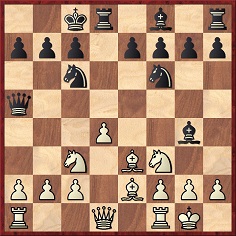
8...e5 9 Ng5 Be6 10 Nxe6 fxe6 11 Bf3 exd4 12 Bxc6 bxc6 13 Qf3 dxe3 14 Qxc6 exf2+ 15 Rxf2 Bc5 16 White resigns.
The Ladies v Gentlemen match, played on 9 May 1942, was reported on page 131 of the June 1942 BCM:
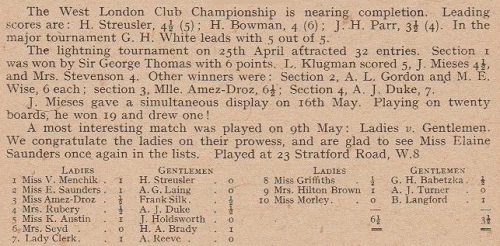
Laing’s game against Elaine Saunders, who was then aged 16, was published on pages 152-153 of the July 1942 issue:
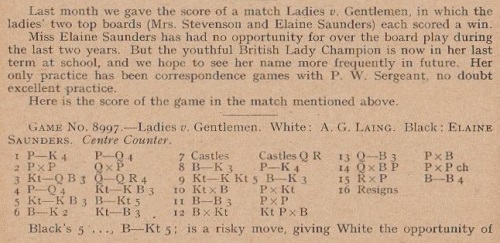

9381. Böök
When the name of the Finnish master Eero Böök (1910-90) occurs in down-market outlets, there is a rush to produce simple-minded puns running roughshod over accurate pronunciation and spelling. ‘Book knowledge’, ‘Playing by the Book’, ‘Booked up’ and other meaningless variants take just a couple of seconds each to compose.
In phonetic script, the English word ‘book’ is ‘bʊk’, but how is ‘Böök’ pronounced? His entry in the Oxford Companion to Chess by D. Hooper and K. Whyld (various editions) gives ‘bek’, but Henry Tanner and Kimmo Välkesalmi (both from Helsinki) inform us that this is wrong. Although the two consonants in ‘Böök’ are pronounced as in English, the vowel sound is as in the German word ‘hör’, i.e. a slightly longer version of the vowel sound in the French word ‘jeu’. In phonetics, therefore, ‘Böök’ is ‘bø:k’.
From our collection, an inscription by Böök in Shakkipakinoita (Porvoo and Helsinki, 1967):
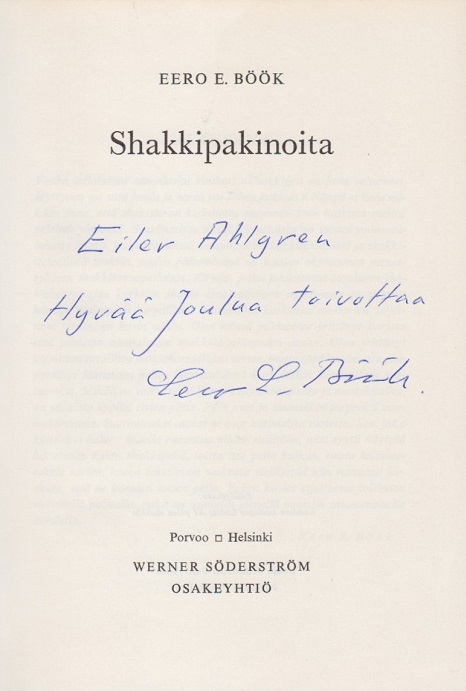
9382. A Tarrasch principle (C.N. 9379)
Jean-Pierre Rhéaume (Montreal, Canada) notes that Tarrasch gave the same principle in the section on passed pawns on page 201 of The Game of Chess (London, 1935):
‘It is better, therefore, to have a mobile majority of pawns on a flank than a blocked passed pawn in the centre, a very important principle laid down by the author.’
From page 285 of the original edition, Das Schachspiel (Berlin, 1931):
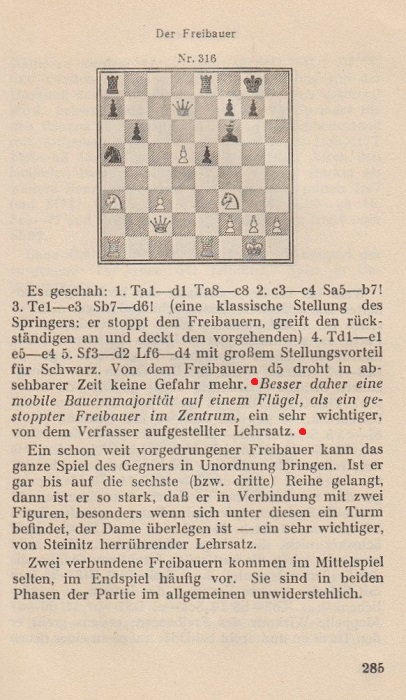
9383. Wild West chess
‘Une partie genre “wild west”’ was the description of the game below when it was published, with notes by Fritz Gygli, on pages 12-13 of the Schweizerische Schachzeitung, January 1950:
Paulin Lob – Harry Kraatz
Lausanne v Geneva match, Lausanne, 6 November 1949
Bird’s Opening
1 f4 d5 2 b3 e5 3 fxe5 Qh4+ 4 g3 Qd4 5 Nc3 Qxe5 6 Nf3 Qh5 7 Nb5 Na6 8 Bb2 f6 9 e3 c6

10 Be2 cxb5 11 Ne5 Qh3 12 Bxb5+ Kd8 13 Nf7+ Kc7 14 Qf3 Qf5 15 Qxf5 Bxf5 16 Nxh8 Nh6 17 O-O Be6

18 Rac1 Be7 19 c4 dxc4 20 Bxc4 Bxc4 21 Rxc4+ Kd7 22 Rd4+ Ke6 23 Rff4 f5
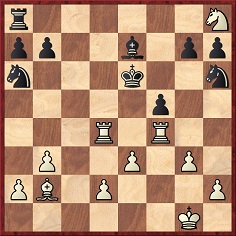
24 g4 g6 25 Rc4 Bf6 26 Rce4+ fxe4 27 Rxf6+ Kd5 28 Nf7 Nxg4 29 Rd6+ Kc5 30 h3 Rf8 31 Rd7 Kc6 32 Re7 Nxe3 33 dxe3 Nb4 34 Ne5+ Resigns.
9384. Comparing Lasker, Capablanca and Alekhine
From an article by the pitifully undependable George Koltanowski, on page 52 of the Chess Digest Magazine, March 1972:
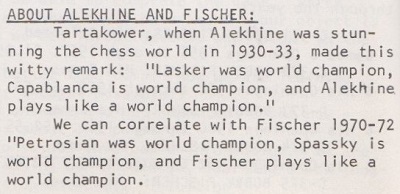
Koltanowski’s reference to Tartakower was given in C.N. 4279, which pointed out that in the 1930s Capablanca was no longer the world champion. We gave mid-1920s references for the remark, and below is what Bernhard Kagan wrote, without identifying the speaker, on page 344 of Kagans Neueste Schachnachrichten, 1 July 1925:

A similar observation (‘Capablanca has the title, Lasker has the results, but only Alekhine has the style of a real world champion’) appeared in an article by Tartakower in issue 4-5 of Shakhmaty, 1925. It was reproduced on page vii of the Baden-Baden, 1925 tournament book by N.I. Grekov (Moscow, 1927):

Elsewhere, Tarrasch has been named in place of Tartakower. From pages 176-177 of The Great Chess Masters and their Games by Fred Reinfeld (New York, 1952):
‘It was the St Petersburg International Tournament [in 1914] that catapulted Alekhine to world fame as a grandmaster and not merely a brilliant player. The main object of attention was of course the duel between Lasker and Capablanca, but Alekhine came very near to stealing the show by thrusting Rubinstein, Nimzowitsch and Bernstein aside and then outpacing Tarrasch and Marshall and coming a fine third to Lasker and Capablanca. It was in this famous tournament that Alekhine first displayed that white-hot fusion of logic and fantasy that was to enthrall chessplayers for three decades; that was to prompt Tarrasch to declare later on that “Lasker used to be the world champion, Capablanca is the world champion, but Alekhine plays as a world champion should play.”’
Given that Alekhine, aged 21, finished well behind
Lasker and Capablanca at St Petersburg, 1914 (by a margin
of 3½ points and 3 points respectively), it is odd to
suggest that he ‘came very near to stealing the show’.
What Reinfeld termed ‘a fine third’ was called ‘a poor
third’ in the entry on Alekhine in the Oxford
Companion to Chess (1984 and 1992 editions) and ‘a
bad third’ on page 46 of Championship Chess by
P.W. Sergeant (London, 1938).
An earlier claim that Tarrasch made the remark about the three world champions was published on page 86 of Chess World, 1 May 1946, in an article, ‘Glimpses of Alekhine’, by M.E. Goldstein:
‘Before Alekhine defeated Capablanca, Dr Tarrasch, a man not given to fulsome praise, wrote that “Lasker was world champion, Capablanca is world champion, but Alekhine plays as a world champion should play”. To the man in the street, Alekhine was the man to watch – the sacrifice of the queen for a mating attack represented the triumph of mind over matter, which everyone could appreciate. On the other hand, the positional cavortings of a Capablanca or a Rubinstein were beyond the ken of ordinary men.’
When presenting Réti v Alekhine, Baden-Baden, 1925 (under the heading ‘The Gem of Gems’) on pages 110-111 of the 1 June 1946 issue of Chess World, C.J.S. Purdy wrote:
‘We disagree with Mr Goldstein when he says that Alekhine’s chess is easier for the ordinary player to understand than Capablanca’s. Capablanca’s moves may often surprise, but usually their logic is soon apparent after examination. But many of Alekhine’s moves depend on some surprise that comes far too many moves ahead for an ordinary mortal to have the slightest chance of foreseeing it. Alekhine’s chess is like a god’s. One can revere, but never hope to emulate.’
9385. Kasparov on chess and women
C.N. 1916 quoted some of Garry Kasparov’s replies in an interview published on pages 61-73 of Playboy, November 1989. They included the following on page 70, in response to the question, ‘How about women chess players?’
‘Well, in the past, I have said that there is real chess and women’s chess. Some people don’t like to hear this, but chess does not fit women properly. It’s a fight, you know? A big fight. It’s not for women. Sorry. She’s helpless if she has men’s opposition. I think this is very simple logic. It’s the logic of a fighter, a professional fighter. Women are weaker fighters.
There is also the aspect of creativity in chess. You have to create new ideas. That’s quite difficult, too. Chess is the combination of sport, art and science. In all these fields, you can see men’s superiority. Just compare the sexes in literature, in music or in art. The result is, you know, obvious. Probably the answer is in the genes.’
The interviewer then said: ‘Do you realize that you’re expressing a sexist point of view, and that Western women will be enraged by it?’ Kasparov replied:
‘Yes, but I’m not concerned. I’m sure that women can do many things better than men in many fields. I think it’s wrong to want to be compared all the time, to want to be equal in everything. Men and women are different.’
9386. Chess by telephone
An item on page 183 of CHESS, February 1971:
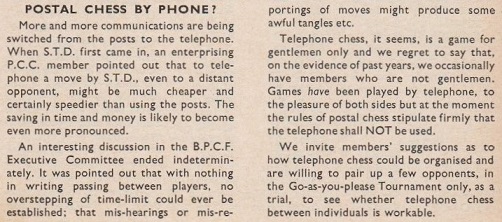
In response, J.N. Walker had a letter published on page 375 of the September 1971 issue:

Telephone chess received only a vague, insular entry on page 482 of the Encyclopaedia of Chess by Anne Sunnucks (London, 1976):
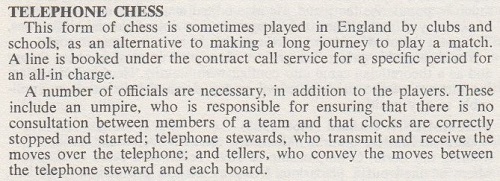
The entry on page 416 of the Oxford Companion to Chess by D. Hooper and K. Whyld (Oxford, 1992) had some specifics, though all were confined to England:
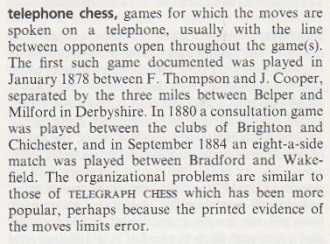
A list of ‘milestones’ in Chess The Records by K. Whyld (Enfield, 1986) gave, on page 9:
‘1878 First match by telephone, in Derbyshire.’
None of the above-mentioned books offered any sources.
From page 69 of the Chess Player’s Chronicle, 1 March 1878:

A single game (not a match) was referred to, and it was said merely to be the first ‘in this country’. Earlier that year, the Chronicle had carried reports on chess played by telephone in the United States:
Chess Player’s Chronicle, 1 January 1878, page 17

Chess Player’s Chronicle, 1 February 1878, page 45
The Hartford Times column of 3 January 1878, which gave the score of the game and described the accompanying ‘telephoniosities’, can be viewed online.
Steinitz wrote about the game in his Field column of 26 January 1878:
‘According to an account of the Hartford Times (Connecticut, US) the telephone has already been utilized for transmitting the moves of a chess game. The parties to the contest, which took place at Hartford, were Mrs J.W. Gilbert, the lady champion of America, and Mr J.G. Belden, on the one side, and Messrs A.E. Olmste[a]d and C.G. Lincoln on the other. The novel way of carrying on the game created a great deal of amusement amongst the members of the Hartford chess circle, who in separate parties attended at the two stations, which were miles apart; and the powers of the telephone for purposes of general conversation were often tried during the intervals between the announcement of the moves. The game was left unfinished, owing to the lateness of the hour.’
A year later, some practical information was provided on page 12 of the Cincinnati Commercial Tribune, 11 January 1879:
‘The telephone system, as it advances, is going to make chess clubs popular. It will be a pleasant thing, after the labors of the day, to go to your chess rooms and carry on a match by telephone with some other club within the range of the central office. The District telephones now being introduced into Cincinnati are so easily managed by anyone who can speak distinctly and are so inexpensive that every chess club in this corner of the State should secure one. The cost of a connection at present would be three dollars a month for each club. The Commercial office has one of the instruments, and the chess editor can say from his own observation that it is perfectly well adapted for chess matches.’
Only one pre-1878 reference to chess by telephone has been found, a seven-word gossip item (‘Chess has been successfully played by telephone’) on page 1 of the Daily Critic (Washington, DC), 29 October 1877:

9387. The Myers Openings Bulletin
Are any readers aware of an index to the Myers
Openings Bulletin, which was produced on an
irregular basis by Hugh
Myers from November 1979 to December 1996?
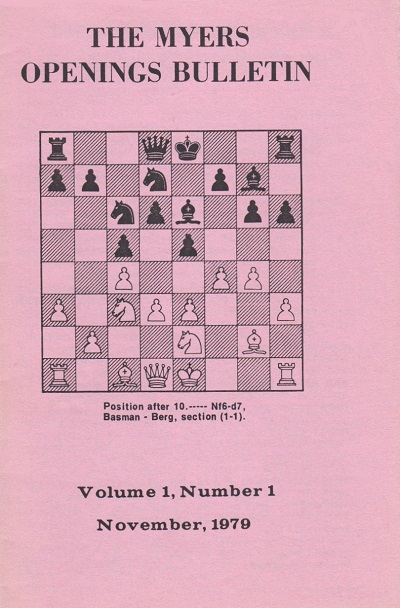
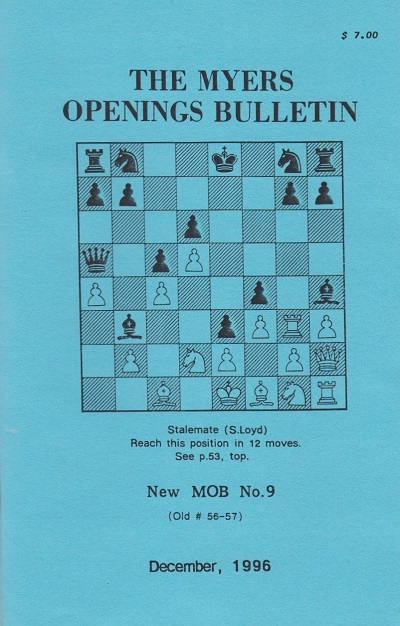
Although the main focus was on unusual openings (the first issue began with an article on 1 a3), the magazine offered much else too, including frank, authoritative book reviews and clear-sighted scrutiny of topical issues. In the final edition, pages 45-49 discussed women’s chess, and a sample paragraph follows, from page 46:
‘A couple of truths are undeniable: there is more than muscular strength to distinguish men from women, and women don’t play chess as well as men. Before the feminist hordes descend, note that I said “don’t”, not (necessarily) “can’t”. This may not be the same everywhere, but a generous estimate is that not over 5% of rated players are female. The difference is more pronounced at the top, where only one woman (Judit Polgar) is in the top 100 players; I think she is the only one who has ever been. As for quality of play, how many books have you seen that are the “best games” of particular women? Which openings are credited to women? You might say it just shows their good taste, but since the MOB started in 1979 not one woman has ever paid me for an MOB subscription, except as a gift for someone else.’
Myers then discussed some theories and scientific studies on the difference between male and female chessplayers. As ever in such cases, reading the full article is recommended.
9388. The 2002 Prague Agreement
From our collection:
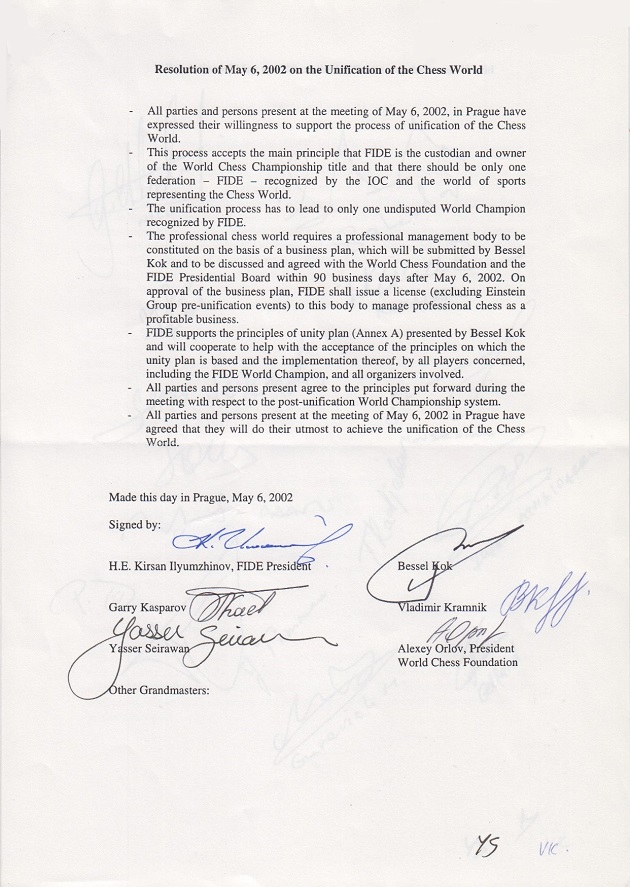
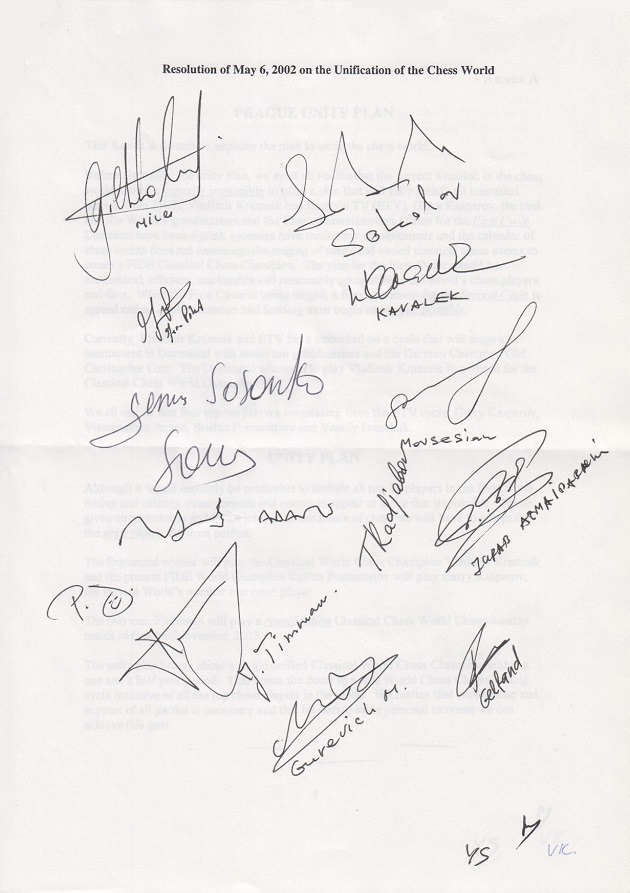

9389. Pillsbury in Chicago
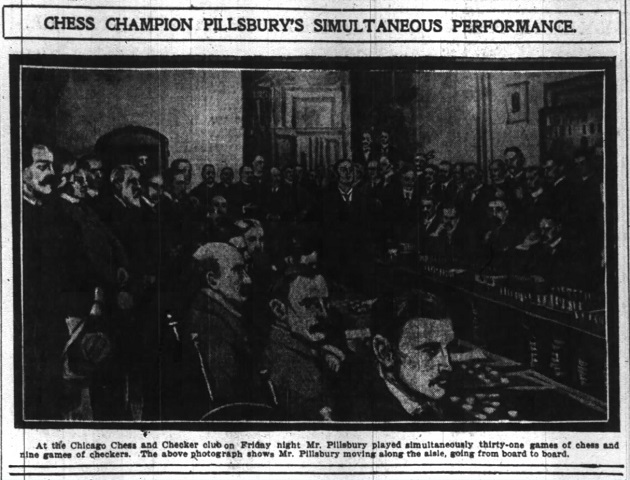
Chicago Tribune, 3 November 1901, page 19
A larger version helps little. Is it possible to find a better copy of the photograph?
9390. Footage
From Olimpiu G. Urcan (Singapore):
‘The Associated Press and British Movietone have just made available a large volume of archival footage, including much chess-related material. It can be consulted via the Associated Press official archive website and/or YouTube. Some highlights:
Salo Flohr and José Raúl Capablanca in simultaneous exhibitions in Prague, 1935;
Elaine Saunders (aged 11) playing blindfold against her father in 1937;
Hastings, 1963-64 (Tal, Gligorić and Gaprindashvili);
Hastings, 1964-65 (Hindle, N. Littlewood, Gheorghiu and Gaprindashvili);
Petrosian v Spassky world title match, 1966;
Havana, 1966 Olympiad (including Spassky, Fischer and Fidel Castro);
Hastings, 1966-67 (including Botvinnik, Hartston, Balashov, Czerniak and Mecking) plus further footage (with sound commentary) of the participants, with emphasis on Mecking;
- Fidel Castro attending a chess exhibition in 2002.’
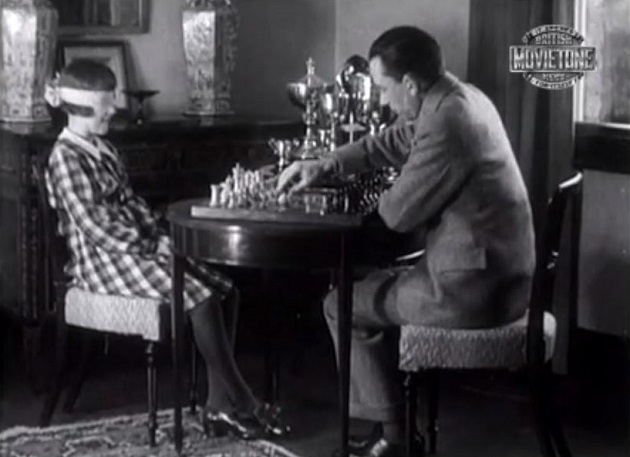
Elaine Saunders
9391. Spassky v Fischer, Reykjavik, 1972
Olimpiu G. Urcan also points out a series of links to film coverage of the 1972 world championship match.

9392. Chess in New Orleans, 1847
Robert John McCrary (Columbia, SC, USA) writes:‘In his column in the Illustrated London News of 25 December 1847, page 411, Staunton answered a correspondent, “Senex”, as follows:
“There is a good deal of Chess-play, we are told, at New Orleans, although the strongest player, Mr Rousseau, is no longer a resident there ...”
No further details were provided, but this reference to New Orleans chess, as known to Staunton in England at the time, is interesting in view of the presence there of the ten-year-old Paul Morphy.’

9393. Paul Morphy at Spring Hill College
An early appearance of Morphy’s name in print was on the front page of the Daily Picayune, 14 October 1854:
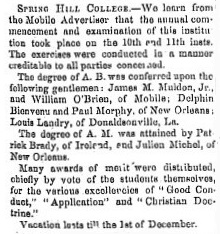
9394. The Book of Chessmen
Our copy of The Book of Chessmen by Alex Hammond (London, 1950) was inscribed by him and includes an advertising card for his business in London:
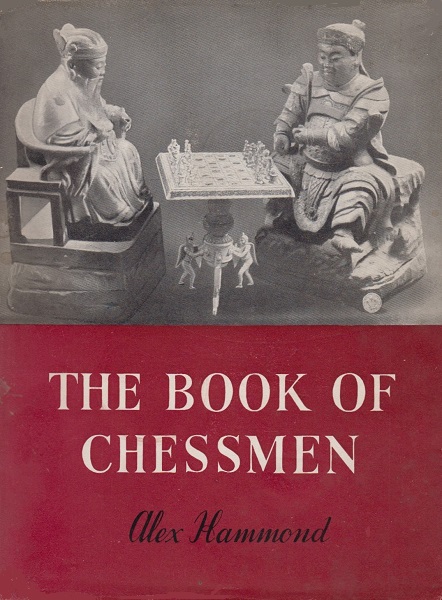
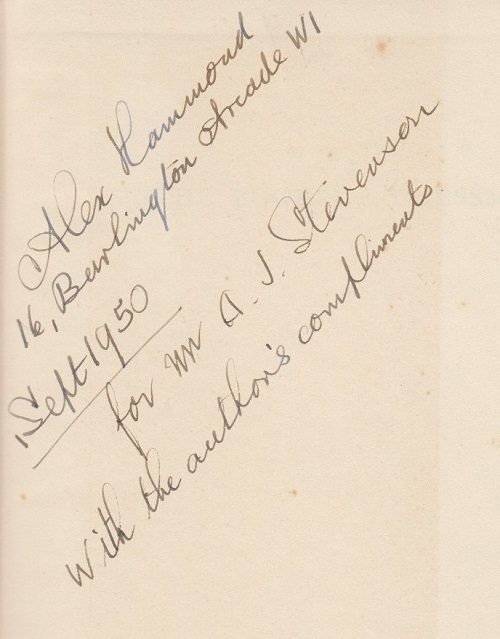

9395. Fleissig v Schlechter (C.N.s 1128, 6665 & 6668)
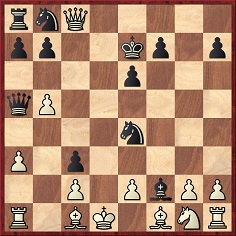
Position after 13 Bc1
From John Saunders (Kingston-upon-Thames, England):
‘If I am reading it rightly, the Allgemeine Sport-Zeitung cutting (C.N. 6665) gives the move order as 13...Qxb5 14 Bf4 Nd7 15 Qxa8 rather than 13...Nd7 14 Qxa8 Qxb5 15 Bf4. This is an important difference as 13...Qxb5 cuts out the possible White continuation 14 Qxb7 which is available after 13...Nd7 and which might have muddied the waters somewhat. When I looked at the game as usually given, even before noticing this discrepancy, it had struck me as surprising that Schlechter should have played the loose and speculative 13...Nd7 rather than the more obviously solid and menacing 13...Qxb5, which computers confirm is more deserving of exclamation marks than the knight move. Did Schlechter perhaps play 13...Qxb5 after all?’
We have drawn together the previous C.N. items on this famous game in a new feature article, Fleissig v Schlechter, Vienna, 1893, but have also noted a further discrepancy in the score, from the game’s publication (with only Fleissig named, as the loser) on pages 52-53 of the February 1894 Deutsche Schachzeitung:


1 b4 e6 2 Bb2 Nf6 3 a3 c5 4 b5 d5 5 d4 Qa5+ 6 Nc3 Ne4 7 Qd3 cxd4 8 Qxd4 Bc5 9 Qxg7 Bxf2+ 10 Kd1 d4 11 Qxh8+ Ke7 12 Qxc8 Nd7 13 Qxa8 (White can play 13 Qc4.) 13...dxc3 (13...Nxc3+ wins at once.) 14 Bc1 Qxb5 15 Bf4 Qd5+ 16 Kc1 Be3+ 17 Bxe3 Nf2 18 Bxf2 Qd2+ 19 Kb1 Qd1+ 20 Ka2 Qxc2 mate.
In short, did Schlechter play ...Nd7 on move 12, 13 or 14?
9396. A Zukertort loss
Page 342 of the November 1877 Deutsche Schachzeitung:

The allies were Eduard Hammacher, Carl Kockelkorn, Carl Leffmann and Carl Wemmers. As shown below, Steinitz had presented a slightly different version of the score in The Field. Three of his notes are included, from the issue dated 29 September 1877, page 375:
1 e4 e5 2 Nf3 Nc6 3 Bb5 a6 4 Ba4 Nf6 5 O-O Nxe4 6 d4 b5 7 Bb3 d5 8 dxe5 Ne7 9 Ng5 Nxg5 10 Bxg5 Bb7 11 Qf3 c5 12 c3 Qd7 13 Nd2 Ng6 14 Rfe1 d4 15 e6 (‘Finely played. From this point the attack is conducted by the allies in a well-planned and most vigorous manner.’) 15...fxe6 16 Rxe6+ Be7
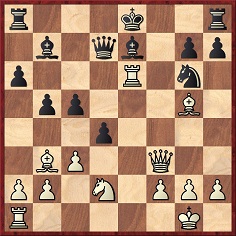
17 Qf7+ (‘This beautiful problem-like move would not have disgraced any of the finest compositions of Herr Kockelkorn, who was one of the consulting allies; but we are not informed at whose suggestion it was adopted. If the Q be taken, no less than mate on the move follows by R takes B, double ch.’) 17...Kd8 18 Rxe7 (‘All this is played in masterly style.’) 18...Nxe7 19 Re1 Re8 20 Be6 Qd6 21 Bf5 h6 22 Re6 Qc7 23 Bxe7+ Resigns.
The note to 17 Qf7+ was corrected by Steinitz in The Field, 6 October 1877, page 408:
‘Our remark in note (e) to the game published last week that White, in the suggested position, would mate on the move, is an obvious slip. The correct version is that White would win a piece on the move.’
The 13 October 1877 issue of The Field, page 430, pointed out that two moves (11...c5 12 c3) had been omitted from the score. Those moves, it will be observed, were not taken into account in the diagram published by the Deutsche Schachzeitung. An abridged version of Steinitz’s annotations was given on pages 304-305 of La Stratégie, 15 October 1877.
9397. Gallery
Dan Scoones (Coquitlam, BC, Canada) reports that there are many high-resolution chess photographs at the Russian Gallery website.
9398. Tayan
From page 156 of the 14 January 1938 CHESS:
‘A new young chess wizard has just burst into the news. Not an Esthonian but an Eskimo. Russian scientists wintering on Wrangel Island in the Chutkhotsk Sea taught some of the natives chess. One of the latter, Tayan by name, took to the game like a fish to water and finished first above several strong players among the Russians in a tournament.’
Corroboration of this report is sought.
9399. Borochow v Fine
A comment about the game Borochow v Fine, Pasadena, 1932 from page 145 of How to Play Chess Like a Champion by Fred Reinfeld (New York, 1956):
‘This is the most remarkable tournament game – certainly the shortest – ever won by an amateur against a first-class master. The chances are slight indeed that such a feat could ever be equaled.’
9400. Najdorf v Cortlever
On pages 120-122 of the May 1946 issue of Le monde des échecs Tartakower annotated the game Najdorf v Cortlever from the 1939 International Team Tournament in Buenos Aires. His concluding notes:
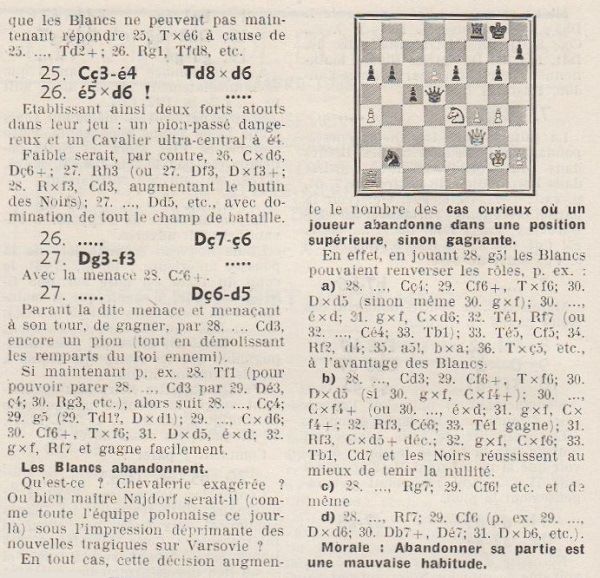
The game was also given on pages 226-227 of Chess World, 1 November 1946, under the title ‘Resigns??’. After quoting Tartakower’s final note (including ‘Moral: Resigning is a bad habit’), Purdy commented:
‘We hope beginners will not use Dr Tartakower’s witticism as an excuse for dragging on hopelessly lost games. Friendly games, by the way, should be resigned earlier than match games. By resigning quickly, you give time for another game – more fun and more practice.’
| First column | << previous | Archives [132] | next >> | Current column |
Copyright: Edward Winter. All rights reserved.
